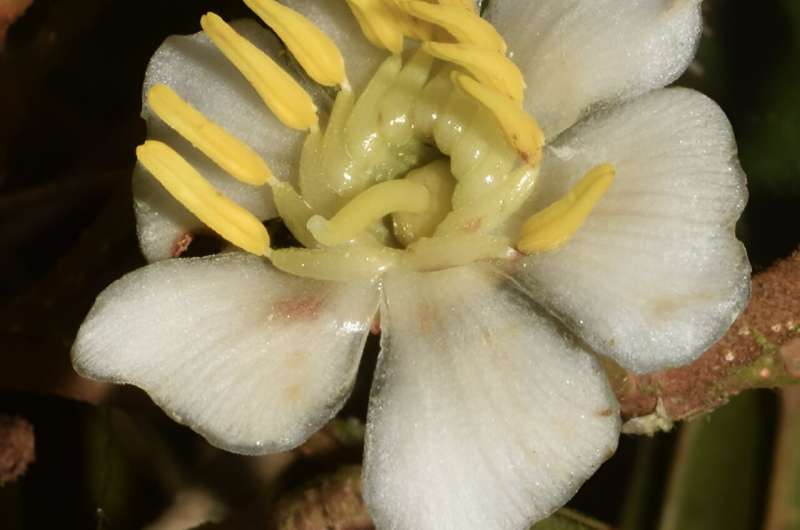This article has been reviewed according to Science X's editorial process and policies. Editors have highlighted the following attributes while ensuring the content's credibility:
fact-checked
trusted source
proofread
Researchers discover seven new plant species in highly threatened cloud forests of Peruvian Andes

An international team of researchers, including a scientist at The New York Botanical Garden (NYBG), has documented and described seven rare new plant species with brightly colored flowers that are only found in highly threatened forests of the Andes Mountains in Peru.
Using internationally accepted conservation status categories, the researchers believe that four of the new species should be classified as Endangered and three as Critically Endangered, a status only one step away from being extinct in natural habitats.
The species all belong to a single genus—a group of closely related species—in the Melastomataceae family of tropical plants, a large and diverse family about two-thirds of whose species are found in the New World tropics. The researchers describe the new species in "Taxonomic and chorological novelties in Blakea (Melastomataceae: Pyxidantheae) from Peru with a list of species for the country," published in Phytotaxa.
Previously, 24 species in the genus Blakea had been documented in Peru. The discovery of seven new Blakea species in the country represents a significant increase in science's understanding of the country's plant life and emphasizes the urgency of protecting the forests where they are found.
"This research adds greatly to our knowledge of the biodiversity in the Andes," said Fabián Michelangeli, Ph.D., Abess Curator of Tropical Botany and Director of the Institute of Systematic Botany at The New York Botanical Garden. "The fact that we can increase the number of species in a country for a genus with very showy flowers by almost 30 percent in a single publication is further evidence of the need to document the species of poorly known ecosystems."
The new species that are described and illustrated in the paper are Blakea eden, Blakea quinta, Blakea wilderi and Blakea yumi from Peru's Department of Amazonas, Blakea pavida and Blakea rojasiae from the Departments of Amazonas and Cajamarca, and Blakea leoniae from the Departments of Amazonas and San Martin.
Most of the new species have been documented in only three or four locations, and researchers found one (Blakea yumi) in only one location within a protected area. Many of the high-altitude cloud forests in which the species grow are under increasing threat of being cut down as agriculture and livestock operations encroach on unprotected natural areas.
These forests are known for their high levels of endemic species—that is, species that can be found nowhere else. Most of the forests where the new species are found are outside government parks and conservation areas, and they are all threatened. Cloud forests are especially important ecosystems because the headwaters of many rivers used for irrigation, drinking water, or other uses are found there.
Using the criteria of the International Union for Conservation of Nature, which maintains the Red List of the world's threatened plant, fungal, and animal species, Dr. Michelangeli and his colleagues believe that Blakea pavida, Blakea quinta, and Blakea yumi should be recognized as Critically Endangered, meaning the species are at severe risk of going extinct in their wild habitats. The remaining four species should be considered Endangered, they say.
The researchers used plants collected during field trips and dried, preserved herbarium specimens to distinguish new from existing species. As part of the research, Dr. Michelangeli, a leading authority on the Melastomataceae family, used the scanning electron microscope at NYBG's Pfizer Plant Research Laboratory to study detailed aspects of plant specimens that allowed the researchers to further distinguish the species from close relatives.
In the paper, lead author Robin Fernandez-Hilario, a Ph.D. candidate at the Federal University of Paraná in Curitiba, Brazil, and co-authors note that in the last 30 years, a considerable number of new Melastomataceae species have been documented in Peru, but the genus Blakea has been underrepresented in these discoveries. Among the reasons they cite for this gap is the fact that Blakea species tend to be epiphytic plants—meaning they grow on other plants—that can be difficult to find in high canopy forests. Also, exploration and collection in highly diverse areas such as the Andean forests has been lacking.
In addition to NYBG and the Federal University of Paraná, the research team was drawn from institutions in Peru and China.
More information: Robin Fernandez-Hilario et al, Taxonomic and chorological novelties in Blakea (Melastomataceae: Pyxidantheae) from Peru with a list of species for the country, Phytotaxa (2024). DOI: 10.11646/phytotaxa.635.1.1
Provided by The New York Botanical Garden


















